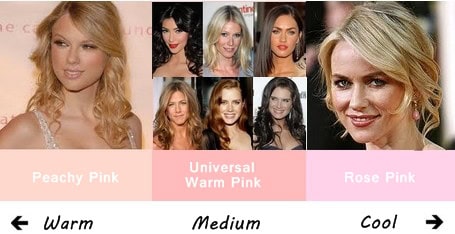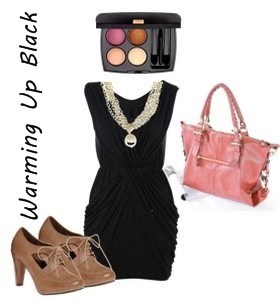Troubleshooting the Seasonal Color Analysis
I’m sure that the Color Me Beautiful’s seasonal color analysis has left you with many questions, so here are some of the FAQ’s regarding the color analysis system – that will hopefully solve the troubleshooting.
Seasonal Color Analysis FAQ #1:
I’m Torn Between Two Similar Seasonal Groups
I receive emails about this a lot. Many have emailed me and said that they seem to look good in a majority of colors from two similar groups. Eg. Deep Winter and Deep Autumn. That’s when the Flow Color Analysis comes into the picture.
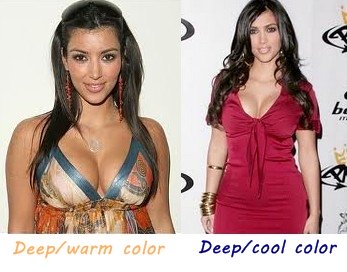 Kim Kardashian can wear both Deep Winter and Autumn colors
Kim Kardashian can wear both Deep Winter and Autumn colors
It works like this:
The 12-group seasonal color analysis system takes into account that you may have color characteristics from more than one season.
A classic example is of a Deep Winter. A Deep Winter may have predominantly black hair with a bluish undertone which is a sign that she’s a cool. But she may also have a warm skin tone which makes it possible for her to wear some of her group’s sister palette – Deep Autumn.
So basically you have a primary season but with characteristics (your secondary season) from another season. However, your secondary season is usually similar to your dominant one. Eg. Light Spring and Light Summer, Warm Spring and Warm Autumn.
Here’s the flow season color chart:
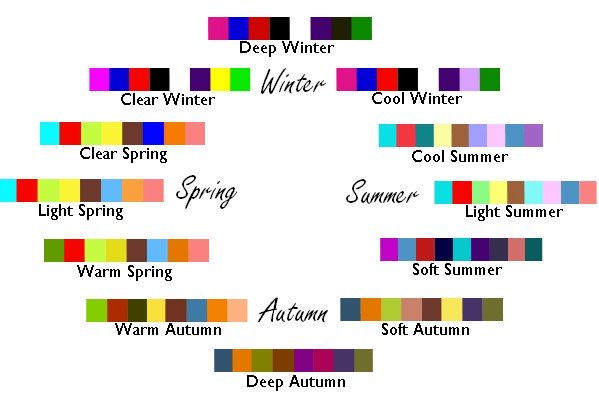
This basically means that you can wear many of the colors from your group’s sister palette.
For example, if you’re a Cool Summer you can wear some of the colors from Cool Winter palette. Or if you’re a Clear Spring you can pull off the colors from the Clear Winter palette as well.
Also, if you have blonde ashy hair which is considered a cool characteristic along with a warm characteristic such as golden brown eyes it may be an indicator that you’re a neutral, a Soft-muted – which means that you’re flow between Soft Summer and Soft Autumn and can wear both palettes. It means you have both warm and cool undertones equally present in your coloring.
Here is another chart with celeb examples:
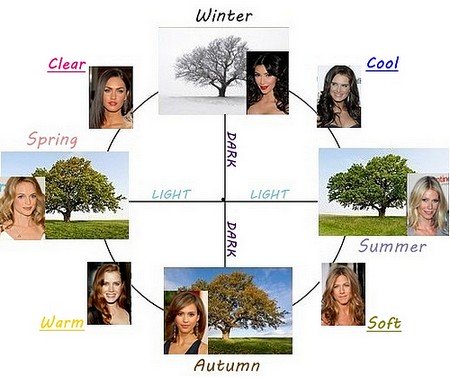
Have in mind that many of the colors in both sister season groups (eg. Deep Winter and Deep Autumn) overlap with each other. That’s why Deep Autumns can wear black successfully because they flow in to Deep Winter.
If you look closely at the flow chart, a Deep Autumn is really a blend of Autumn and Winter. It means that they have a warmth of a typical Autumn season but the intensity of a Winter, however depending on their unique mix of coloring, they will look better in one color palette than the other.
![]() Note: If you are a (dominant) Deep Winter with a mix of both cool and warm undertones, you can usually wear the deepest colors in the Deep Autumn palette.
Note: If you are a (dominant) Deep Winter with a mix of both cool and warm undertones, you can usually wear the deepest colors in the Deep Autumn palette.
However you might find yellow-orange based colors to be horrible colors. That’s because they’re too warm and bright. On the other hand, if you’re a Deep Autumn (dominant) you may only be able to wear the warmest, deep colors in the Deep Winter palette, but not the vivid and bluish ones.

Kim Kardashian look so-and-so in bright yellow despite her fab smile! She would have looked better in it if she was more tanned (Deep Autumn-like). For her Deep Winter look, a lemon yellow is more suitable because of its cool look.
Credit to WENN
A sure-way to figure out your dominant group if you’re stuck between two similar ones, is to do a test drape. Which means to test if you’re cool or warm – if you look best in true red or tomato red, silver or gold, teal or royal blue. Take the gold or silver test.
Seasonal Color Analysis FAQ #2:
I Don’t Belong Anywhere in the Seasonal Color Analysis
The coloring combinations added to each group in the color analysis are examples of what is typical. Of course, there are exceptions. However, remember that this analysis is based on your dominant characteristic, and not the combination of your coloring. What is the one character (eye, hair, skin) that seem to dominate your appearance?

Is it the deep and rich hair? Crystal blue eyes? Delicate, blonde hair? And the list goes on here in the seasonal color analysis. This makes sure that the analysis works everyone, regardless of race and ethnicity! Learn more about the color theory behind the seasonal color analysis.
![]() Note: If your coloring seems to be a little bit of everything (warm and cool, neither deep or dark) it may indicate that you’re a Soft-muted, but have your colors done with a professional to be absolutely sure.
Note: If your coloring seems to be a little bit of everything (warm and cool, neither deep or dark) it may indicate that you’re a Soft-muted, but have your colors done with a professional to be absolutely sure.
For Women of Color
If you’re a woman of color make sure you measure your coloring in relation to your ethnicity. For example Beyoncè is considered dark for Caucasians but medium among African-Americans, so her palette is different from for example Alek Wek who is on the deepest level of dark coloring in the seasonal color analysis. Learn more about color analysis for ethnic women.
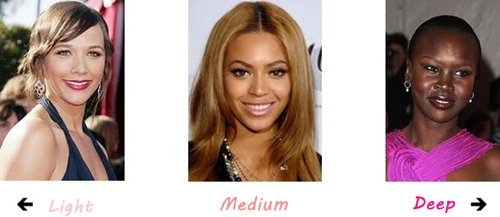
If you’re in doubt (there are also some exceptions) have your colors done with a professional, and preferably with an experienced certified color analyst who knows how to work the new 12-color system.
You can also find lots of hints and tips on analyzing your coloring correctly in Lora Alexander’s 111 page book Color Revival. I couldn’t have explained the seasonal color analysis better. Read my review of the book and get a copy.
Seasonal Color Analysis FAQ #3:
Skin Color’s Undertone
In many instances, your skin tone is less significant than hair and eyes when determining your seasonal group. Why? Because a person can have warm undertone but cool overtone, and some people can appear neutral.
However if you see a definite coolness or warmth to your skin tone then that can play a big role in defining your coloring. BUT the skin tone is not alone in determining your coloring.
To confirm if you’re dominantly warm or cool, I suggest to take a Gold or Silver test, which is exactly what a color analyst do in a consultation with a client. However it’s possible to do it virtually by using a software to ‘clothe’ a person with various colors.
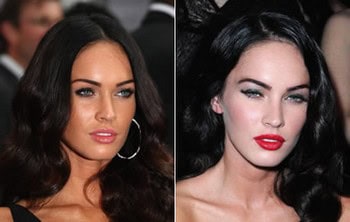 Megan Fox when she’s tan and pale.
Megan Fox when she’s tan and pale.
See how a tan can mask a person’s skin undertone? Despite her orange skin, her blue eyes and black hair have the most impact in her appearance and are considered to be her most dominant characteristic.
Seasonal Color Analysis FAQ #4:
Neutral Coloring: Being Warm and Cool
Usually, people with a neutral coloring are called Soft-muted and can pull off both warm and cool colors – and/or colors that are in-between, neither warm nor cool, deep nor light.
If you’re a Soft-Muted you’ll notice that your coloring is light, rich but mute. You can for example have light blonde hair which is indicates that you’re a Light but with brown eyes which is a typical dark characteristic.
Or you may have a multi-colored, mousy hair with blue-green eyes. These are typical examples of Soft-Muted. Think Jennifer Aniston. Or Mary Kate and Ashley Olsen. Katherine Heigl also comes to my mind.
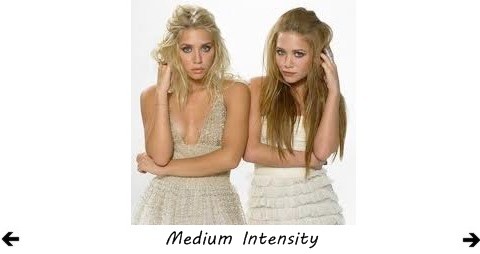
Mary Kate and Ashley Olsen are Soft-muted because of their neutral look and can wear a range of colors, but they look best in muted shades. Ashley has dyed her hair blonder, making her coloring cooler – so she’ll be able to wear more of the Soft Summer color palette. These colors are basically soft colors leaning more on the delicate and light side.
Seasonal Color Analysis FAQ #5:
Will My Season Change If I
Dye My Hair/Wear Color Contacts/Tan?
Yes, but within your own season (eg. Winter, Spring, Summer, Autumn) or your color palette’s ‘sister group’ (eg. Clear Winter and Clear Spring). Some women may notice that when they dye their hair lighter they can wear lighter colors.
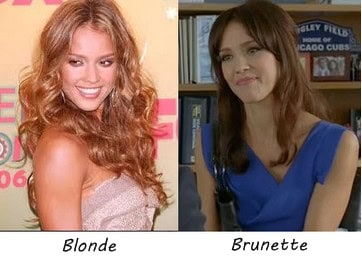
When you color your hair to a lighter shade your palette opens up to lighter shades of color.
When Jessica Alba was blonde she could pull off softer colors but they didn’t look her best because of her dark eyes, which are almost black. Also when her hair is dark she’ll be able to wear darker colors such as royal blue which is a Deep Winter color. Her natural coloring is Deep Autumn.
With me, whenever I dye my hair golden-reddish brown I can wear many of the Warm Autumn colors. But if I put on some of the Soft Autumn colors I start to look bland – and that’s because the colors here are muted and won’t hold against my dark brown eyes.
It’s just a bit too far from my own seasonal group. However if I dye my hair black-brown I can pull off many of the colors from the Deep Winter palette.
Seasonal Color Analysis FAQ #6:
What Happens When I Age?
Because we lose a little bit of the color in our skin, hair and eye color (not least the graying) over the years, your coloring will soften and cool down.
The rich and vivid colors you used to wear may now seem too intense or warm on your coloring. So a Cool or Light palette is common among aging women.
Unfortunately Springs and Autumns with noticeably warm coloring look worse than Summer and Winters when their hair is graying – that’s because the cool grays in their hair looks bad on warm coloring.
However their palette will continue to change as their coloring softens and grays, and ‘fit’ more with the Cool color palette. Cool seasons such as Summers and Winters gray gracefully because they already have a cool coloring.
Seasonal Color Analysis FAQ #7:
Isn’t One Color Palette with Only 22 Colors a Bit Limiting?
Now there is a common misconception when it comes to color swatches and color palettes. Just because you receive a palette with your seasonal group’s best colors, it does not mean that you are limited to those colors and that you have to wear the EXACT same pink that shows in the palette. There are endless nuances of each color.
The color swatches are there to be your visual reminder of what colors you look best with. For example if you’re a Clear Winter, your rule of thumb is to look for colors that have a bright and/or vivid quality to it. For Deep Autumns – deep colors with a warm undertone. You get my idea. The Color theory will give you clearer understanding of how it works.
![]()
Here is an example of a harmonized color palette. This is a typical Warm Autumn palette.
![]()
Palette that looks like a mess. The colors don’t look good together
![]() Note: The correct way to use a color swatch is to take a piece of garment and hold it against the swatch and see if they harmonize with each other. I mean come on, how big is the chance of finding the EXACT same colors on your swatch… 🙂
Note: The correct way to use a color swatch is to take a piece of garment and hold it against the swatch and see if they harmonize with each other. I mean come on, how big is the chance of finding the EXACT same colors on your swatch… 🙂
Seasonal Color Analysis FAQ #8:
I Love Pink/Blue/Yellow/etc., But it’s Not on My Color Palette!
Never give up on a color if you love it and feel is you. But I wouldn’t sacrifice a healthy complexion for a color… However, there aren’t (and shouldn’t) be any complete off-limits when it comes to colors. It’s all in how you combine the colors and where on your body you place them.
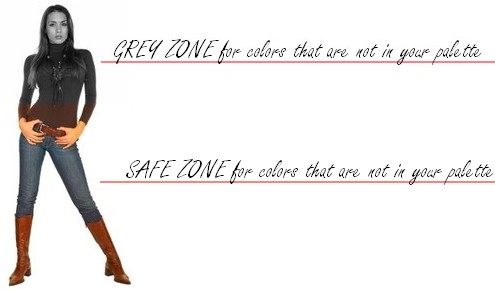
Any color worn from your waist up can in different degrees affect your complexion (hair, eyes, skin = face). Anything you place around or on your face (earrings, necklace, makeup, scarf) are quite crucial to looking your best.
However the further down you place a color the less effect it gives on your face. The downside is that not everyone find pink skirts and shorts appealing 🙂
Here’s an outfit example of how to wear a color outside your palette:
![]() This is how you can wear some cool pink in your outfit. You can also wear a pink dress or top but then you really should work on warming or brighten it up with your best neutrals.
This is how you can wear some cool pink in your outfit. You can also wear a pink dress or top but then you really should work on warming or brighten it up with your best neutrals.
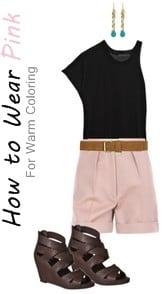
The Right Shade of Pink
It showed how much I hung on to a color because I was used to wearing it. Off-white (and also light beige and creamy white) has been one of my favorite color ever since that discovery. And with the seasonal color analysis, everything now makes sense 🙂
Color Revival
Still clueless on which group you belong to? Lora Alexander’s ‘Color Revival’ book which brings up answers and explanations regarding everything about the seasonal color analysis. Includes real-life photo examples. Read my review on ‘Color Revival’ and get a copy.
Another way to make it work is to select pinks with the same undertone and quality as your own coloring (see: color theory). If you have a warm coloring, peach will do. You could also try a universal warm pink which looks good on anyone.
